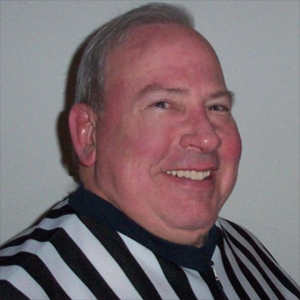
Rndballref
20 Years Experience
Chicago, IL
Male, 60
For twenty years I officiated high school, AAU and park district basketball games, retiring recently. For a few officiating is the focus of their occupation, while for most working as an umpire or basketball referee is an avocation. I started ref'ing to earn beer money during college, but it became a great way to stay connected to the best sports game in the universe. As a spinoff, I wrote a sports-thriller novel loosely based on my referee experiences titled, Advantage Disadvantage
This is a tough judgement call. If, both boys simultaneously held the ball or put force on the ball in opposite directions (as in a stuffed blocked shot) then it should be called a held ball (jump ball going to the possession arrow). If the ref rules that there was not dual possession then you have to call a foul and/or subject a player to really getting hurt. This does not happen too often at the boy's varsity level (quick and strength), but it happens. Opinion: good officials have a quick whistle for held balls to avoid the weaker player always getting a foul.
A player throwing the ball in on a spot throw in is restricted to a 3 foot wide, and unlimited deep area. At least one foot must be in or on this area. There is no travelling possible on a throw in. Now, to your question, a throw in player is allowed to dribble as long as the dribbling is out of bounds. Hypothetically if the throw in player dribles in bounds and then touches the ball it is a turnover because the throw in player was out of bounds and touched the ball which was put in bounds when the dribble hit the playing floor. If the throw in is after a basket, of course there is no 3 foot wide area.
Since the defender hit the ball, the offensive team no longer has control of the ball, nor did they gain control when it grazed the offensive player. So, no possession right before the ball entered the backcourt, no backcourt violation . Bad call, ref.
The answer to your question is no. If the previous award was in error, it was either correctable or uncorrectable depending on when it was discovered. If the second foul still does not put you in the bonus you should not be awarded any free throws. The fact that a mistake was made on the previous free foul does not mandate a second mistake (assuming both of these fouls occurred with less than 7 team fouls).
MBA Student
 Is business school a party compared to law or med school?
Is business school a party compared to law or med school?
Basketball Referee
 Do you think the nets should be lower for girls?
Do you think the nets should be lower for girls?
TV Meteorologist
 Do most meteorologists believe global warming exists?
Do most meteorologists believe global warming exists?
I have never seen that, but I would administer as follows: I would not allow a disqualified player to shoot the free throws. Since free throws are administered in the order the fouls were committed, 1) bring in the sub, 2) the sub shoots the free throws awarded o the fouled out player, 3) team b shoots the technical fouls, 4) team b gets the ball at half court.
I think this is the same question you asked 2 questions above. The answer is that unless it is a flagrant (technical) foul, the push is considered a team control foul. No free throws are awarded to team B, but they are awarded the ball at the point nearest the infraction.
A defender has the right to a vertical space if he gets there before the offensive leaves his space to move. Therefore, a defender can be moving and still take a charge. The rule book calls this moving obliquely - that is away or angled. If an offensive player turns into a space the defender is entitled to, it is a charge.
-OR-
 Login with Facebook
Login with Facebook (max 20 characters - letters, numbers, and underscores only. Note that your username is private, and you have the option to choose an alias when asking questions or hosting a Q&A.)
(A valid e-mail address is required. Your e-mail will not be shared with anyone.)
(min 5 characters)
By checking this box, you acknowledge that you have read and agree to Jobstr.com’s Terms and Privacy Policy.
-OR-
 Register with Facebook
Register with Facebook(Don't worry: you'll be able to choose an alias when asking questions or hosting a Q&A.)